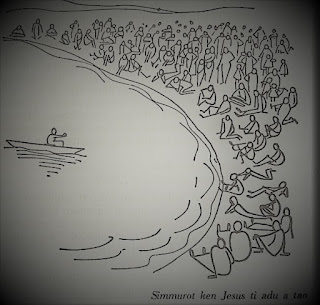Noli Me Tangere: The Enigma of Mary Magdalene
 |
| Mary Magdalene Artist: Guido Reni (Baroque era) source: link here. |
For the first three days of Easter, the Gospel readings take us to the resurrection narratives in which Mary Magdalene plays a major role:
- Easter Sunday: Mary Magdalene becomes the first person to report about the happening at Jesus' tomb (John 20:1-9)
- Octave of Easter - Monday: Mary Magdalene and the other women are the first persons to receive the Easter message and on their way to report it, they meet the Risen Lord (Mattew 28:8-15).
- Octave of Easter - Tuesday: Jesus appears to Mary Magdalene (John 20:11-15).
Mary Magdalene: An Enigmatic Figure
Actually, you can be a millionaire with Mary Magdalene, like Dan Brown who raked millions of dollars for his salacious story of Mary Magdalene and Jesus; and earlier, Martin Scorsese for his movie. The "Last Temptation of Jesus."
Mary Magdalene remains an enigmatic figure in popular culture. Even Jose Rizal titled his novel, Noli Me Tangere, lifted from Jesus’ reaction to Mary Magdalene in today’s gospel, Touch me not!
The enigma and charisma of Mary Magdalene are as old as the varied accounts of her by the Gospel writers: from someone who was exorcised of seven demons in Luke to one of those women who discovered the empty tomb in the Synoptic Gospels, and to the most privileged person to be the first witness the Risen Lord in John’s Gospel.
From the Sermon of Pope Gregory I in the sixth century up to recent times, we would conflate the different stories of women in the four gospels and assign them to Mary Magdalene: the anonymous woman who anointed Jesus’s feet with perfume and whom Luke identifies her as “sinner” is Mary Magdalene who is also Mary, sister of Martha and the brother of Lazarus in John’s Gospel and the woman accused of adultery —thus Mary Magdalene becomes Magdalena – kalapating mababang lipad.
Prior to the 1969 reform of the Liturgy, the Gospel Reading for the memorial mass of Mary Magdalene is from Luke’s account of the woman-sinner anointing the feet of Jesus.
We can’t blame Pope Gregory, without that Sermon, we would have been deprived of the sensual portraits of Mary Magdalene by great Renaissance and Baroque era artists and our own sumptuous statues of her processed during Holy Week.
An Intimate Mary
Forgiven and beloved (pinatawad - inibig), would be a good line for the so-called HUGOT, but such tradition of affection goes back as early as the early third century A.D., many years before the Gnostic Gospels (Gospel of Philip and Gospel of Mary, the basis of Dan Brown’s novel) would ridiculously imagine a physical intimacy between Jesus and Mary Magdalene.
In particular, the restless woman-lover in the Song of Songs (First Reading for her Feast) who searches passionately day and night for her beloved or “sweetheart” (NJB) prefigured Mary Magdalene who searches for the body of Jesus on that Sunday morning.
It was Hippolytus in 235 AD who first thought of this allegorical interpretation and now preserved in the OT reading for the Feast of Mary Magdalene. It was also the same Hippolytus who coined the title of Mary Magdalene Apostola Apostolorum (the "Apostle of the Apostles").
The Song of Songs is the only kind in the Bible, the poetry of eros par excellence that the rabbis found it first scandalous to be included in the Hebrew Bible.
A few years ago, Pope Francis has elevated the liturgical celebration of Mary Magdalene from an obligatory memorial to a Feast at par with the other male Apostles. The text of that document speaks of those two traditions about Mary Magdalene: as the apostle of the apostles being the first witness and first to be sent to announce the Good News of the resurrection; and or while at the same time affirming that she was a woman “who so loved Christ and was so greatly loved by Christ (a quotation from Rabanus Maurus).
The very special love of Mary Magdalene for Jesus then can teach us that we can also be intimate with the Risen Lord, esp. at this moment of crisis and fear. We want to feel that we are loved and embraced by God (like a post that says, "payakap po, Lord!").


Comments
Post a Comment